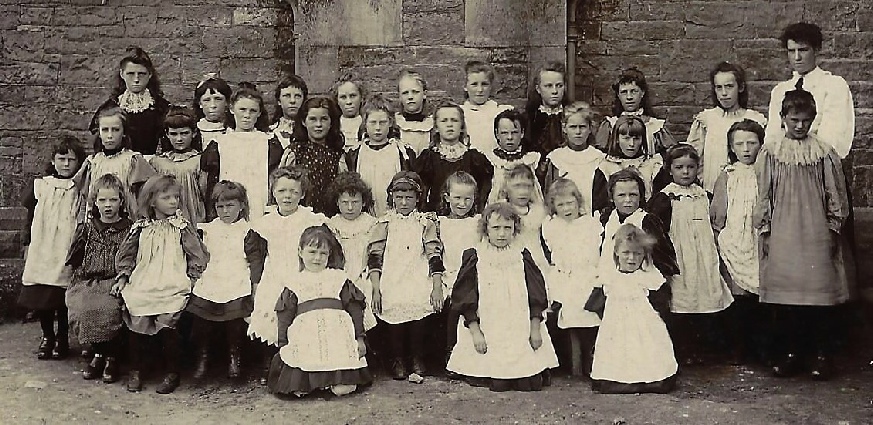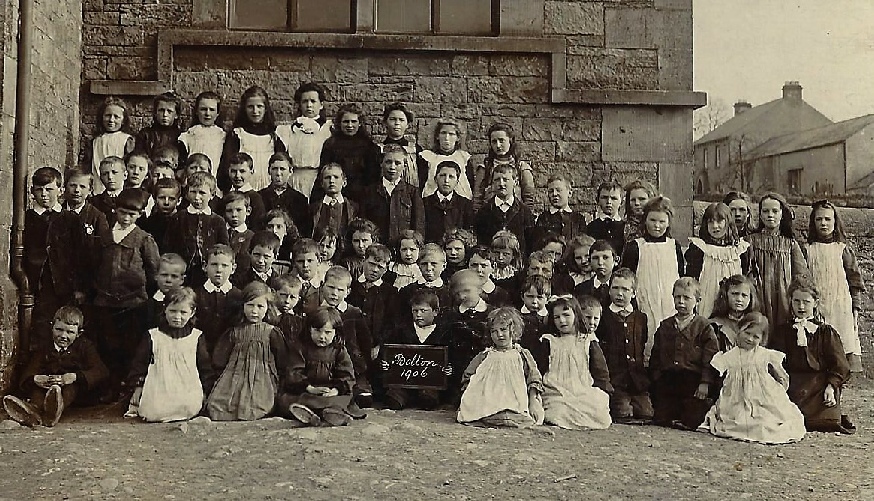History Ch 5
Bolton School

The church records show that at least two of the curates of Bolton were licenced to teach school; Nathanial Beck in 1663 and John Breeks in 1693. Robert Nelson taught school in the years 1671-1673, 1675 – 1678, and William Martin son of the vicar of Warcop was licenced in1674 and could have taught in that year when there was a gap in Robert Nelsons service William Parkin taught at Bolton from 1680 – 1681. He was formerly school master at Orton and Warcop and later became the curate of Asby being ordained as a priest
There may have been a separate school but it is more likely that the classes were held in the curate’s house which abutted the church yard. In the smaller endowed schools and chapelry schools it was frequently the curates who were in charge and not all were well educated men. Good school masters and clever scholars could move to the better endowed establishments in other parts of Westmorland or further afield.
The key to the growth of education in the area was through the five major grammar schools acquiring close relationships with Cambridge and Oxford for the establishment of scholarships and exhibitions. Some of those Westmorland people who became successful in their chosen field would then take an interest in their old school and county.
There is evidence that a free endowed school has existed in Bolton since 1731. It may have stood on the track leading to Mr Ewbank’s land between the poplars and the new houses at Hillcrest.
Eventually a school was built by subscription and endowed with several benefactions to pay for the costs. James Hanson curate of Bolton left 40/- in his will dated1st July 1721:-
I give and bequeath to the Reverend ffrancis Thompson of Brough & the said Thomas Hanson the sum of forty pounds of like current money to purchase a Temporall or Reall Estate of Inheritance the yearly Rent or profit thereof to be employed for the teaching Schooling or Instructing off four or more of the poorest of the Children of the Inhabitants in Bolton aforesed.
His widow gave a further 10/-for teaching four or more of the poorest children of the inhabitants of Bolton.
Thomas Hanson’s tomb stone was once fixed to the south wall of the church but now stands inside the church porch. A verse from Hanson’s epitaph reads:-
Who to this town poor out of his store
His last will makes relation
Ten pounds he gave and forty more
For children’s education
This money was initially used to buy land which was later sold for 100/-. Joseph Railton a successful London merchant endowed 40/- ; for the poorest children in the township and William Bowness gave 50/- in 1762; the income to come once in every seven years. The singing master to teach the singing of psalms in chapel, otherwise for the poor children.
Williams’s son had been educated at Bolton and Appleby Grammar School and became a Major General in the British Army. Dr Michael Richardson a clergyman in Berkshire gave 50/-in 1765, Nicholas Dent gave 50/- in 1782 and by bequest of John Fallowfield 21/- in 1802; for the education of the poorest children.

A new school was built on the old site in 1856 (where Tarka House stands today) at a cost of £500 paid for by Mr Richard Tinkler of Eden Grove. There was no accommodation for the master but later Glynn House became available for the head teacher.
In 1865 the school was described as a mixed elementary school. There was one master receiving 13/- a year from the endowment and 32/- from fees and other sources. Between 30 and 40 boys and girls attended the school and most were described as being very young. Thirteen children paid a reduced fee of 1/- on account of the endowment.
The school was not connected to any religious denomination but prayers were said before and after school and a Sunday school was held there every Sunday. The village green was the playground. The school was open for 46 weeks of the year and the children spent five hours and forty five minutes a day in school with two breaks for recreation. The children were taught English, writing and mathematics and one of the benefactors had asked that Latin also be taught.
The school was governed by the master and three yeomen of Bolton and when any vacancies occurred they were filled by persons voted in by the remaining governors. In 1867 the trustees were; the Reverend W Shepherd, Colonel Rigg, J Dent yeoman, M Savage Yeoman, T Simpson Yeoman and the master was W Jennings.
The schools were inspected just as our schools are today and the following account is the report the school inspector Mr. D. C. Richardson provided in the late 1860’s:
On account of the 13/- a year arising from the endowment, 13 children are instructed at a reduced charge of 1/- a quarter. Instruction in Latin is prescribed by one of the benefactors, but it is not now taught, nor does the master profess to be able to teach it. A new building was erected by private munificence in 1856 which contains besides the school room a library and reading room for the use of the township. There is fair accommodation for the 30 to 40 children belonging to the school most of them being very young. Only 20 were present on this occasion, and only one had reached 12years of age, the average even in the highest class was but 10 years. Their attainments were of a very modest kind: in arithmetic three only had advanced so far as the reduction of money, the rest being either too young to have begun the subject, or at best practising the simple rules. The spelling of a few boys was comparatively good and pains had been taken to inculcate some principles of English grammar but geography and English history are not attempted. The girls on the whole are more backward than the boys and their attempts to write a very easy passage from dictation betrayed in several cases almost complete ignorance.
The master has been at the school two years and is still a very young man. It is difficult to secure the services of a practical or highly qualified teacher on so small a remuneration as is here offered but it would seem to require neither long experience nor superior attainments to raise the average proficiency of these children.
Mr Richardson’s report tells us something about attitudes to education at the time. In the earlier Victorian years the age that children in the country started school depended on the circumstances and attitude of their parents. If the mother was employed outside the home or if she had other younger children school attendance might begin as young as two years of age. The teachers would accept these babies because they realised that if they didn’t the older ones would be kept at home to look after them.
Much of the absenteeism was not only caused by children being kept at home to look after younger siblings but by children being sent to work in the fields to mind sheep or pick stones and especially at such times as hay making. Until fees were abolished in 1891 many children would have been forced to stay at home because of the lack of money. The fees may seem very small; one or two pence a week but this represented a major outlay especially if there were several children of school age. If the head of the family, usually the father was unemployed or on short time this would also mean there was no spare cash for schooling. Some children might play truant and who would not be tempted on a beautiful spring or summers day in such a lovely village as Bolton?
Was Mr Richardson showing his own attitude towards female education when he describes the girl’s ability to write a very easy passage from dictation? Females were discriminated in education well into the mid 1950’s. He does say how difficult it is to attract good teachers on such a small salary but gives the impression the master was not very able and could try harder!
Mrs Maisie Parkin came to modern day Bolton School as head teacher in 1957 and stayed for 27 years. The first six years of her appointment were spent in the old school with Mrs Waiting as her assistant. Space in the old school was at a premium and many old pupils will recall having to walk to the old corrugated church hall for school dinners. School plays also had to be performed there.
The school today stands on a new site and was opened in the 1960’s by the chairman of the North Westmorland Rural Council, Mr J. Millray. It was built at a cost of £17,000 and was designed by the county architect Mr W. R. Wark to the latest specifications of the time. The three main rooms could be made into one by a removable partition.
In 2000 the school had 38 pupils; 14boys and 23 girls their ages ranging from 4 – 11 years. Vanessa Richards was the head teacher assisted by two other teachers. The school had an infant and junior playground and a sports field. A varied curriculum offered a range of extra-curricular activities including a computer club, netball and football clubs, guitar, recorder, clarinet and flute tuition, school productions and residential visits. The school had and still has strong links with the local community and supports a variety of charities.
 Back row left to right: Ernest Wilson, Fred Brunskill, Joe Longmire,Fred Slack, William Milner, Robb Nicholson, Tom Wooff, J Parkin,Jonathan Nicholson, Willie Elwood. 2nd row left to right: Harry Slack ,Tom Dixon, Frank Slack, Jos Hugill, Jack Robinson, Jack Lambert, Harry Graham, Tom Hugill, ? Albert Woof, Robert Dixon. Front row left to right Tom Richardson, Charlie Woof, Willie Hugill, Ramsey Chester, Isaac Tomlinson, Harry Hullock, ? Hugill, Harry Bowson, Stanley Holmes, John Hugill. |
|
With Miss Jane Jennings Pupil Teacher. Five Girls were absent on the day the photograph was taken. Unfortunately no names are given for the girls. |
|
|
|
|



